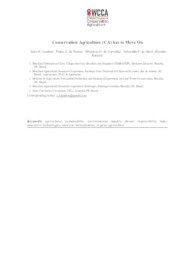Conservation agriculture (CA) has to move on.
Conservation agriculture (CA) has to move on.
Author(s): LANDERS, J. N.; FREITAS, P. L. de; CARVALHO, M. O. de; SILVA NETO, S. P. da; RALISCH, R.
Summary: After nearly five decades, zero tillage (no-till), the bedrock of CA, is dejá vu in Brazil. But CA is not just leaving the soil protected with residues or cover crops and planting/drilling crops through them, quality CA also requires a pluri-annual rotation, frequently absent. It is also evolving by incorporating new compatible and sustainable technologies. Farmers, including organic ones, are learning how to incorporate innovative biological and mechanical methods for disease, pest and weed controls, reducing pesticide and fertilizer use; the Farmer Responsibility Index underlines significant recent reductions in chemical hazards. As consumers demand greater food traceability, certification and benchmarking will continue to expand, while increasing complexities in soil, water, crop and livestock management are demanding higher skill levels and widespread use of specialized consultants. The success and longevity of the CA movement will depend on incorporating and promoting new compatible and sustainable technologies, such as biological controls, precision agriculture, controlled traffic farming, and drones for scouting and spot spraying. CA then provides land use intensification to reduce horizontal expansion, improved aquifer re-charge, erosion control and other important environmental benefits, plus increased profit and lower food prices, with less negative environmental impacts. Historically, the environment has suffered, therefore, the above urgently requires more promulgation, backed by research. To expand the scope, and hence the definition, of CA, the following questions need to be addressed: (i) can CA become the umbrella definition for all these technologies; and, (ii) how do we adjust the concept to achieve this? One approach would be a CA base definition, with clarifying adjustments, and a list of approved compatible technologies. A challenge that needs to be addressed js from the novel label "Re-generative Agriculture" (RA), not yet scientifically defined but clearly based on CA principles. One approach would be to recognize CA as a sine qua non of agricultural sustainability, especially in the tropics, and the need to define additional science-based technologies that differentiate new labels from CA.
Publication year: 2021
Types of publication: Paper in annals and proceedings
Unit: Embrapa Soils
Observation
Some of Embrapa's publications are published as ePub files. To read them, use or download one of the following free software options to your computer or mobile device. Android: Google Play Books; IOS: iBooks; Windows and Linux: Calibre.
Access other publications
Access the Agricultural Research Database (BDPA) to consult Embrapa's full library collection and records.
Visit Embrapa Bookstore to purchase books and other publications sold by Embrapa.

